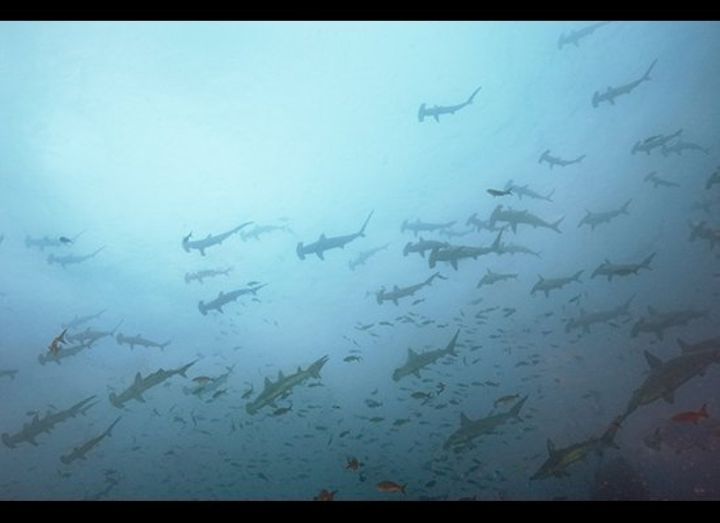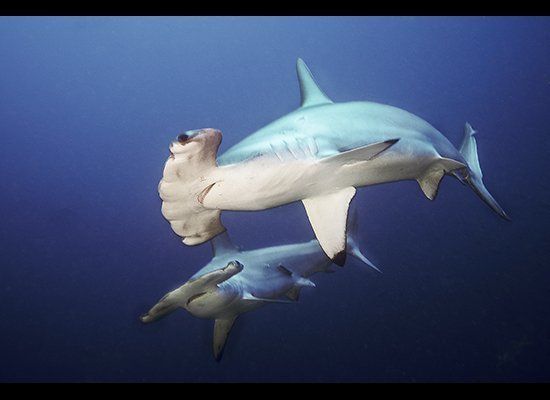
Some people's greatest fear is to find themselves in the water with a shark. Others travel for days to put themselves in that situation. Such was the case for the 19 eager divers, including myself, who flew to Costa Rica from all over the globe in order to ride for 36 hours on a boat to Cocos Island, where hundreds of sharks school.
Diving in Cocos was unlike anything I had done before, and many of my divemates (some with more than 3,000 dives under their belts) agreed. When the action kicks in, it's hard to keep up. One second you are trying to count the number of scalloped hammerhead sharks swimming over your head (and the myriad colorful fish turning the water into a dynamic pointillist seascape) and the next you're paralyzed by a 12-foot Galapagos shark passing a few feet away. But don't freeze for too long or you may miss an apex predator, the tiger shark, roaming the waters below you.
The beauty, abundance and diversity of marine life in this UNESCO World Natural Heritage Site is unparalleled, offering its neoprene-vested visitors the opportunity to dive with some of the largest numbers of predators and other large animals in the world. The captain of our ship told me that last year he had to bring the boat to a sudden stop because a humpback whale jumped out of the water only a few feet away. On that same day he also spotted Orcas (a rare sight around the island) and pilot whales.
Our trip to Cocos began with a two-hour van ride from San Jose, the capital, to Puntarenas, the port where the liveaboard awaited us. The 340-mile journey to the island can be rough, so motion sickness pills for the vulnerable are highly recommended.
We reached Cocos, the world's largest uninhabited island, in the middle of the night. Waking up to its lush vegetation, which is watered by 275 inches of rain per year, was our first treat. Within minutes of setting our eyes on the water, creatures started to shine through, from marble rays and dolphins to a giant turtle and even a shark, all this without leaving the boat.
Most of this volcanic island's dive sites are islets, submerged rocks or pinnacles, and while the action usually happens between the 60- and 90-foot mark, dives can reach a maximum depth of 130 feet. Currents can be fierce (five of them converge at Cocos) so conditions can change quickly down under, and the inexperienced diver will not feel at ease. As one fellow diver put it, brushing up on your diving skills in Cocos is like learning to drive in a Ferrari.
A "bad day" at Cocos will most likely mean encountering numerous whitetip reef sharks, which you'll find on every dive, a wide range of fish, a few hammerhead sharks, starfish, marble rays and moray eels. But do not despair. The next dive you may run into a 16-foot whale shark, as we did on our fourth day diving, green sea turtles mating or a manta graciously flapping its wings over your head. And even the smaller creatures can make a big impression at Cocos, like the tornado-size schools of jacks we encountered.
Scalloped hammerhead sharks are the island's biggest draw, as large schools are easily spotted, particularly around Bajo Alcyone. Divers claim to have seen hundreds of hammerheads at once in the past, but we were not as lucky, counting at most about 50. Illegal fishing in and outside of the island's marine protected area has taken a significant toll on the island's shark population, but when it comes to hammerheads, water temperature changes are also a big factor.
One immersion that cannot be missed is the night dive at Manuelita, where a mesh of whitetips (more than you'll ever see during a day dive) searches for and catches its prey a few feet below your fins. The instruction is to point all flashlights in one direction, preferably at one helpless victim, to assist the shark in securing its dinner. Some experts worry that such practices could in the long term change the animals' behavior, while others claim that sharks do not use vision to hunt for food so the lights neither help nor obstruct their feeding practices. Just to be safe, I decided to point my lamp sideways, not only to avoid putting a fish at greater risk, but also to make sure the tiger shark was not following my air tracks.
If money is not an issue, especially considering that a 10-day liveaboard trip to the island costs between $4,000 and $5,000, you may also consider hopping on Undersea Hunter's DeepSee, a custom-built submarine for three featuring an acrylic sphere that becomes invisible underwater. Straight out of an episode of "Lost," the submersible descends to a depth of up to 1,500 feet, completely out of light's reach. During our 1,000-foot descent, which has a price tag of $1,800, we encountered three mobula rays with wingspans of approximately eight feet, crabs practicing free-falling off a volcanic rock wall, fossilized bird droppings from thousands of years ago, a deep water (or "prickly") shark and other rare creatures.
Jacques Cousteau, who visited Cocos numerous times, proclaimed it "the most beautiful island in the world." Visit it if you dare, knowing that you will never see the ocean the same way again.
How to get there
The easiest way to get to Cocos, which offers accommodation only to its park rangers and volunteers, is through one of the two well-established liveaboard companies operating there: Undersea Hunter vessels depart at least once a week; Aggressor goes twice a month. Private boats must obtain permits from the national park.
We were on board Undersea Hunter's Sea Hunter, a comfortable and spacious vessel with 10 guest cabins (all with private baths) and capacity for up to 20 passengers. There is plenty of room for equipment, including the private camera/strobe storage shelves with 110 & 220-volt AC power. Strict vegetarians and other picky eaters, myself included, need not despair as the chef and the rest of the staff go well out of their way to meet every passenger's needs.
